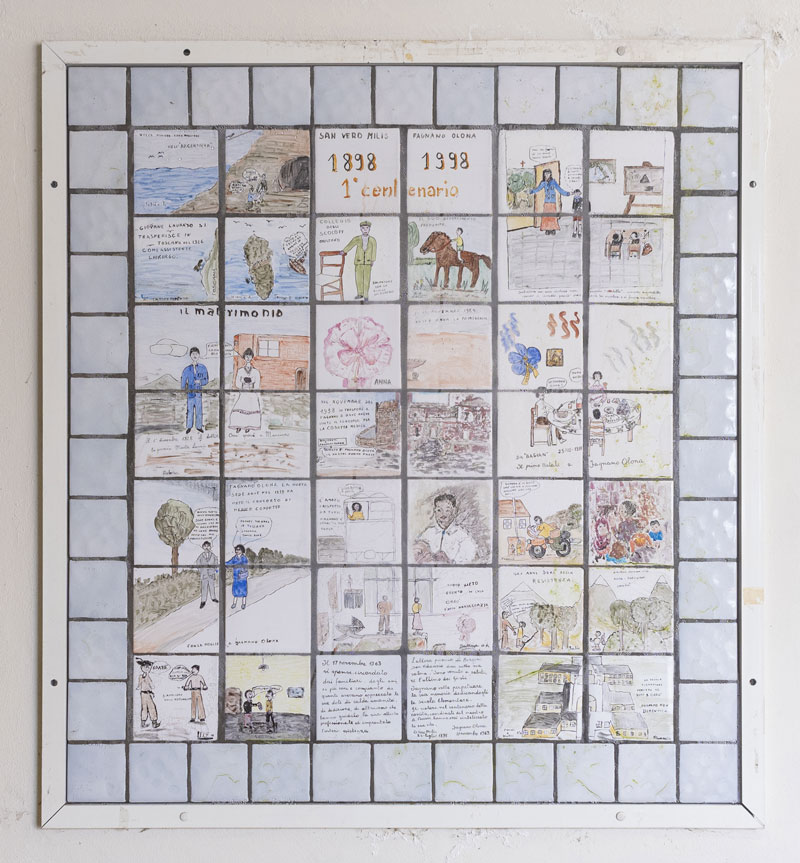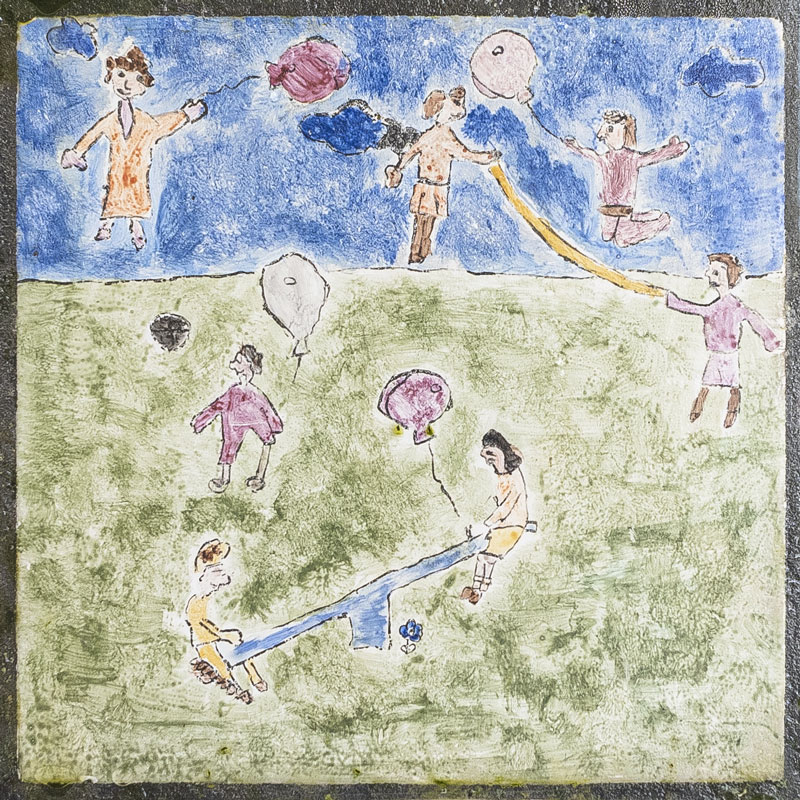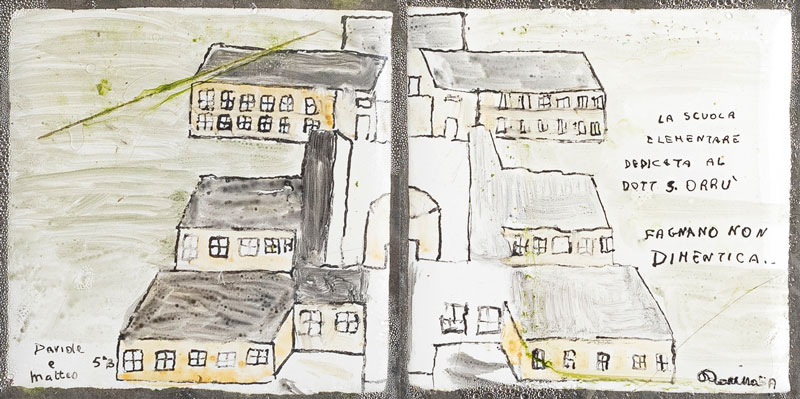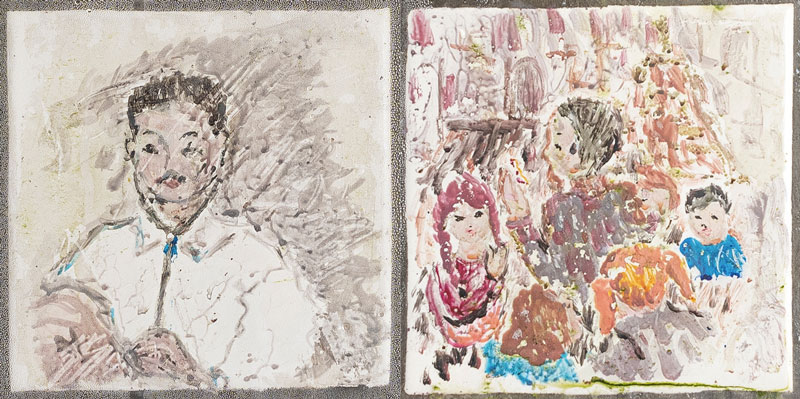Restarting from language education. Interview with Silvana
Loiero
Francesca Belloni, Elvio
Manganaro
Fig.
1 - Image of the ceramic tiles designed in
1997 by the pupils of the elementary school of Fagnano Olona, under
the
guide of the master A. Vaccaro. Photo by Francesco Pavan

Fig.
2 - Image of the ceramic tiles designed in
1997 by the pupils of the elementary school of Fagnano Olona, under
the
guide of the master A. Vaccaro. Photo by Francesco Pavan

Fig.
3 - Image of the ceramic tiles designed in
1997 by the pupils of the elementary school of Fagnano Olona, under
the
guide of the master A. Vaccaro. Photo by Francesco Pavan

Fig.
4 - Image of the ceramic tiles designed in
1997 by the pupils of the elementary school of Fagnano Olona, under
the
guide of the master A. Vaccaro. Photo by Francesco Pavan

Francesca Belloni, Elvio Manganaro:
Today the debate on schools is extremely lively. Is language still the
terrain on which inclusion from exclusion is measured?
Silvana Loiero: Yes, language is
still a factor of exclusion: this is an age-old question, but also a
present-day question. There are Italian-speaking children of all ages,
and therefore born and raised in Italy, who, despite speaking Italian,
only have an apparent command of the language. In front of a written
page or when listening to a lesson they have difficulty in
understanding or have expressive skills limited to a single
“register”; they are unable to vary the forms
through which they can express themselves.
To them we must then add their peers who are excluded because
they speak a different language.
Don Milani’s words come to mind in this regard:
«I call someone a man who is a master of his
language». These are words which still resonate strongly
today. And at the same time we must note the great relevance of
GISCEL’s Ten Rules for Democratic Language
Education[1],,
especially where (in Rule VIII) it is recalled that:
«the development and exercise of linguistic skills
should never be proposed and pursued as ends in themselves, but as
tools for a richer participation in social and intellectual
life».
Today, however, compared to the ’60s and
’70s, we have important official documents on schools in
Italy which set as the purpose of language education the development of
wide-ranging, confident language skills and, as in
the case of the National Guidelines[2], specify that the possession
of adequate levels of control and use of the Italian language represents
«an indispensable condition for the growth of the
person and for the full exercise of citizenship, for critical access to
all cultural areas and for achieving academic success in every field of
study».
The official texts are not sufficient to allow students to
travel the road of scholastic and social inclusion with any agility. In
fact, much more is needed if, as the statistics tell us, the learning
of the Italian language by Italian and foreign children of all ages
continues to produce differences and bring to the fore new inequalities.
ISTAT surveys[3]
have shown us, for example, that in the 2018-2019 school year, 30.4% of
second-year students at upper secondary schools had not achieved
sufficiency in literacy, as found by INVALSI[4] using reading comprehension
and grammar tests. The variations are large across the country (41.9%
in the South and 20.7% in the North) and are also large in terms of
gender, social class and citizenship, with 34.4% of insufficient
literacy skills among boys against 26.3% among girls; 54.2% among
first-generation foreign children, compared to 27.8% among children
born in Italy to Italian parents, 46.5% among children belonging to the
lowest socio-economic and cultural levels, compared to 19.4% among
those living in wealthier families. Furthermore, the percentage of
insufficiency is higher among students at vocational institutes (66.7%)
than among high school students (16%).
In conclusion: we can say that undoubtedly there is still a
problem of exclusion linked to the possession or not of language
skills. However, we must add that today there are other considerations:
distance learning in the COVID period has in fact shown us that not
having a connection and a PC or another type of technological support
available represents a further factor of exclusion. Consequently, the
disadvantage of a lack of access to a network or the necessary means,
those tools through which language travels, is added to the lack of
language skills. These factors are even more exclusive for children who
speak another language.
Consequently, Italy still has many steps to take to increase
the effectiveness and degree of inclusiveness in its school system.
EM: does this
combination still make sense, beyond the most obvious aspects? In what
terms does this relationship stand today? What has changed compared to
the years when the thinking was to correct the imbalances in society,
also through language education?
SL: Naturally, the combination
still has a very significant meaning today. However, it would be
unrealistic to think that the school alone can correct the imbalances
in society: the school can only play a part, and in particular it can
offer tools for participation in the social and democratic life of a
country.
In my opinion, the fundamental function of language education
today is to train citizens who can consciously participate in the
construction of larger and more composite communities, quite apart from
the national one. Ensuring proficiency in Italian while giving value to
native and EU languages makes the school a privileged place for
learning and, at the same time, a space for free and pluralistic
confrontation.
I have already mentioned the document entitled National
Guidelines (for primary and lower secondary schools). In it,
a close link is established between the idea of citizenship,
being able to exercise it fully, and the
acquisition of language skills. To put active citizenship into
practice, a fundamental condition is therefore required: the possession
of wide-ranging, confident language skills. Skills which represent
indispensable tools for citizens to participate in social and political
life actively and responsibly, to feel that they fully belong to a
community, to have a guaranteed set of rights and at the same time be
in a position to fulfil a set of duties. This is why it is important
that at school an effective communication climate is created in which
boys and girls of all ages learn to dialogue, converse, and discuss
things; that is, they are able to express their own opinions, argue,
listen to others, and really understand what they are saying. This is
the way to exercise the right to express their ideas by word,
which is an integral part of constitutional and citizenship rights
(Article 21 of the Italian Constitution).
«It is through the word (…) that shared
meanings are built and work is done to heal differences, to acquire new
points of view, to negotiate and give a positive meaning to differences
as well as to prevent and regulate conflicts[5]».
The practice of the right to express their ideas by
word thus opens the way for dialogue and confrontation,
essential elements of democratic processes in today’s
multicultural societies.
In 2005, the well-known linguist Tullio De Mauro, in
officially opening the Day for the Thirtieth Anniversary of
the Ten Rules (De Mauro 2007), underlined that the earnest
effort of the rules had been to propose a
linguistic education that was not only efficient, but democratic, that
is, aimed at inclusion, to the “not one less”. For
the linguist, and for the GISCEL association which he founded in the
mid-1970s, this was not merely a question of talking about language
education: it was in fact necessary to choose democracy.
Trying to make language education work in a democratic sense
is something different, additional, compared to the simple
linguistic-educational construct. So said De Mauro. And
today, fifteen years later, his words ring even truer: it is necessary
to achieve equality and democracy and devote every effort to
building that necessary condition of democratic living which is, in
fact, democratic language education.
FB: With regard to
language in the proper sense, the central question seems to be teaching
and learning not so much (and here I am referring to the words of De
Mauro) how we should say something, but rather how we can say that
thing and, I would add, to decide and understand why to say it or not.
It seems that freedom is still at stake and in ways that are
increasingly difficult to pin down. In this sense, what are the
specific aspects of the current condition?
SL: The traditional
“linguistic pedagogy”, that of the
“theme” and of beautiful writing – so to
speak – was prescriptive, it responded to the logic of how
to say something. But it is easy to explain how to say something, it is
more difficult to explain how to say something and what the effects
from saying that something in a certain way can generate and determine.
In this regard, I would like to recall the well-known motto of
Gianni Rodari: All uses of the word for everyone,
which is well suited to the current zeitgeist, characterized as it is
by the presence of numerous varieties in the Italian linguistic
repertoire and by constant changes in the uses of the language. We must
ensure that children concretely experience the ductility of the
language and become able to adapt to the multiple situations in which
they use it, exploiting its expressive and communicative potential to
make apposite choices. This means giving all the tools to be able to
interact on a linguistic level, enabling them to vary their ways of
expression to adapt them to the environment, society, contexts,
purposes, and interlocutors.
FB: Speaking of
architecture, to what extent can the spatiality of school buildings
help define a learning environment? In your opinion, in what ways does
physical space affect the development of skills, the acquisition of
knowledge, and the enhancement of skills in complex contexts.
SL: In discourses relating to the
educational sciences today we speak of “learning
environments”. This term is generally used in the plural to
indicate innovative schools and classrooms in terms of their school
buildings and furnishings. The expression “new learning
environments” is instead increasingly used as a synonym for
“digital learning environments”; in this case, the
relationship between educational and organizational innovation and
digital competence is emphasized.
However, I would like to talk about the learning environment
in a broader sense, not only as a physical environment but also as a
cultural and mental “space of action”, in which
interactions and exchanges take place between students, objects of
knowledge, cultural and technical tools, and teachers, and there is the
opportunity to have meaningful experiences on cognitive,
affective-emotional, interpersonal and social levels. This more complex
and multi-faceted meaning is linked to recent research in the
psycho-pedagogical field that highlights the importance of school
learning not as an individual process separate from the situation in
which it occurs but as an intersubjective process which implies
collaboration and sharing.
Learning therefore has a strongly social characterization: we
learn from others and with
others. The process of building meanings, acquiring new knowledge,
developing skills, takes place within the social relations between
students and the activities they carry out.
In particular, for the purposes of our discourse, it should be
noted that current research has demonstrated the importance of a
collective discourse taking place in the classroom, both in the forms
of teacher-led discussions and in those of small groups of pupils who
work independently and collaborate to solve a problem. It is precisely
through collective discourses that meaningful knowledge and socially
shared collective ways of arguing and reasoning in specific areas are
built up, thus allowing a “sharing of knowledge”.
Hence, in this sense, the learning environment qualifies as a
“community of discourses” or “of
learners” because, in addition to learning knowledge,
techniques and procedures, children also learn social procedures and
relationships and collaborative practices[6].
It goes without saying that the spaces and equipment must be
geared to the creation of this “community”.
EM: What could be a
way of setting up the relationship between language education and the
language of architecture? Today, it seems to me, all efforts are aimed
at updating spaces. However, if we look at the winning projects for the
construction of new schools, we get the impression that the rhetoric on
the educational possibilities of informal relational spaces (corridors,
stairways, atria, etc.), compared to the traditional classroom unit, is
the mirror precisely of a deliberate resizing of the community and
collective dimensions in the education of children.
SL: The traditional image of the
teacher is linked to giving lessons, a teaching
practice which has always had a central place at school. During a
lesson, the teacher shows, explains, asks questions, gives
definitions, stimulates, prompts... The showing phase is
often followed by exercises done by the students, the assignment of
homework, subsequent interrogations.
Today, however, educational psychology speaks of school
learning not as a consequence of a transmission process but as an
effect of a constructive process, a dynamic process in which learners,
as I have already said, play an active role within contexts in which
they interact with peers, adults, and the tools of their own culture.
Hence, for the purposes of interaction and social exchanges,
the structure of the classroom needs to be changed. In fact, only a
circular arrangement of the desks can effectively allow speaking,
listening, participation in debates, collectively building
argumentation and reasoning strategies in the various fields of
knowledge, and working together in small groups, not only to discuss a
problem or a text read previously, but also to write collectively.
However, the structure of the entire school building should
also be changed, both to make the spaces more attractive and pleasant
and to make them more functional. Classrooms should have French windows
which open out onto a lawn (it would thus be a beautiful encounter
between culture and nature); they should be adaptable to various
functions and equipped with the necessary technological equipment, with
sliding doors which, if necessary, can remain open to ensure that the
space becomes one with a central meeting space. In addition, room
should be found for workshops of various kinds in a school where pupils
can work with their hands and mind, experimenting with and manipulating
materials to do things and learn to do things, while working with
others.
And, in addition to the canteen and the gym, room should be
found for a library in a school, as its beating heart. A library which
becomes a place not only for lending books and autonomous and
collective reading but also for presenting books, and for such
promotional activities as exhibitions, workshop activities related to
the catalogue raisonné, reviews and bibliographies,
multimedia activities, theatrical performances and meetings with
experts, debates, meetings with authors, listening to music...
A library which can also become a place for families to
participate and therefore a venue for meetings and exchanges between
all kinds of people.
Libraries represent a powerful factor for the
growth of reading and, therefore, for the overall growth of the nation.
This what Tullio De Mauro wrote (2010) and we want to recall it at the
end of this chat because we would like the linguist’s voice
to reach the architects who design schools. If for De Mauro the
promotion of reading is a democratic necessity, then a library must be
built into every school. Because, as Antonella Agnoli has written:
«The library is the most democratic place that
exists, open to all: children and adults, Italians and foreigners, poor
and rich. A truly universal place, where it is not necessary to eat or
drink something to sit down, it is not necessary to have a computer, or
an internet subscription because access to the Net is always possible
[...] This is the library: an invention which will still exist when
cars are long forgotten, or are locked up in a museum along with
Ötzi’s mummy» (Agnoli 2009).
Notes
[1]
The Rules, drawn up by Tullio De Mauro in 1974,
were later discussed within the Intervention and Study Group in the
Field of Linguistic Education (GISCEL), a group established within the
Italian Linguistics Society in 1975. In their current form, the Rules
are the result of collective work. To be found [in Italian] on the site
www.giscel.it
[2]
National Guidelines for Primary and Lower Secondary Schools,
in: http://www.indicazioninazionali.it/wp-content/uploads/2018/08/Indicazioni_Annali_Definitivo.pdf
last consulted 05/07/2021
[3]
See the report BES 2020: Il benessere equo e sostenibile in
Italia, in https://www.istat.it/it/archivio/254761
last consulted 05/07/2021
[4]
Istituto Nazionale per la Valutazione del Sistema Educativo di
Istruzione e di Formazione, in
https://www.invalsi.it/invalsi/index.php
last consulted 05/07/2021
https://www.invalsiopen.it/
last consulted 05/07/2021
[5]
National Guidelines for Primary and Lower Secondary Schools, in:
“Annali di Pubblica Istruzione. Periodico multimediale per la
scuola italiana a cura del Ministero dell’Istruzione,
dell’Università e della Ricerca”, 2012.
[6]
For research on “discourse and learning”, see
Pontecorvo C. (edited by) (2005) – Apprendimento e
Discorso. Carocci, Rome; Pontecorvo C., Ajello A. M.,
Zucchermaglio C. (2004) – Discutendo
s’impara, Carocci, Rome.
Bibliography
AGNOLI A. (2019) – “Biblioteca”. In: AA.VV., Dizionario che cura le parole. Edizioni Suigeneris, Turin.
DE MAURO T. (2007) – “Le Dieci tesi nel loro contesto
storico: linguistica, pedagogia e politica tra gli anni Sessanta e
Settanta”. In: GISCEL, Educazione linguistica democratica. A trent’anni dalle Dieci tesi. FrancoAngeli, Milan.
DE MAURO T. (2010) – La cultura degli italiani, a cura di Francesco Erbani, Laterza, Rome-Bari.



